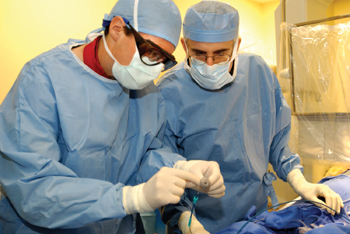
Drs. Thomas Doyle, left, and Robert Piana prepare the device used in the procedure to correct a congenital heart defect in a patient at VUMC this week. (photo by Dana Johnson)
Doctors repair heart defects with non-invasive procedure
Doctors at Vanderbilt University Medical Center can now repair some congenital heart defects, traditionally corrected by cardiothoracic surgeons, with a non-invasive procedure. It’s one of few centers nationally performing the technique called percutaneous closure for both atrial septal defect (ASD) and patent foramen ovale (PFO) for adults and children.
Surgical repair of ASD has long been the only option for patients. PFO patients, with failed medicinal treatment, have also required open-heart surgery. But with the development of percutaneous closure, the need for surgical procedures has been limited.
“Everything is moving to a minimally invasive approach and that includes some surgical procedures,” said Dr. Robert N. Piana, associate professor of Medicine. “We are always trying to figure out ways to treat patients nonsurgically. This is a natural progression.”
ASD, a hole in the upper chamber of the heart, has long been treated in pediatric patients using the non-invasive approach.
With PFO, a potential hole in the heart, many patients can forgo repair for some time, opting for pharmaceutical treatment. An estimated 40 million people (10 percent to 20 percent of the population) are walking around with PFOs. But in a small number of cases, those experiencing unexplained stroke and recurrent ailments, correction of the defect is a priority. In 80 percent to 90 percent of patients, the opening closes on its own within the first month. But in some cases, if left untreated, the congenital defect can lead to heart failure and pulmonary hypertension.
Recent FDA approval of percutaneous closures has allowed both pediatric and adult patients to benefit.
Piana teamed with Dr. Thomas P. Doyle, associate professor of Pediatrics, to offer this technique to adult patients. Doyle was the first to perform the non-invasive closures on pediatric patients with ASD at Vanderbilt and, according to Piana, is the expert in the field. Now the team has treated nearly 30 adults with ASD and about 25 adult PFO cases.
“We offer a team approach to this for the adult patient,” Doyle said. “I think what separates us from other institutions is that we have a team approach. The adult and pediatric cardiology departments are working together for the best care for the patient. This can only maximize their care.”
Doyle said he is training other Vanderbilt physicians, but that the know-how will only be in the hands of a few.
“The technique is relatively complex and there is more time involved in coordinating,” he said. “Plus, there is still a relatively small patient population.”
The procedure, which takes about two hours, is performed in the Cath Lab. Doctors have two types of patches, which are inserted into the body through a catheter. The cardio seal is used in repairing a PFO. The quarter-sized patch acts much like a sandwich. The amplatzer, used to correct an ASD, is a silver dollar-sized, wire mesh, mushroom-shaped patch.
“There are great advantages to having the percutaneous procedure,” Piana said. “Patient comfort and recuperation are a big plus. The biggest advantage, especially for those patients suffering from the effects of PFO, is the prevention of stroke or recurrent events.
“Although the jury is still out – it’s certainly an intriguing approach that can be used to prevent stroke in a certain population. And for ASD patients, preventing right heart failure and pulmonary hypertension from occurring is a goal.”
Doyle said the recovery rates are very impressive in adults. Using traditional therapy to treat closures requires a six-week recovery, while the new procedure will see a patient walking around the next day and functioning within a week.
Piana said the newest technique is not ideal for every patient, but hopes to find answers in an upcoming trial expected to begin this summer. Vanderbilt will be a part of a multi-center trial that will randomize patients to two treatment options to determine the effectiveness of the non-invasive technique.
Other members of the team include Drs. J. Donald Moore, assistant professor of Pediatrics, David Ziao-Ming Zhao, assistant professor of Medicine, Ann Kavanaugh-McHugh, assistant professor of Pediatrics.













